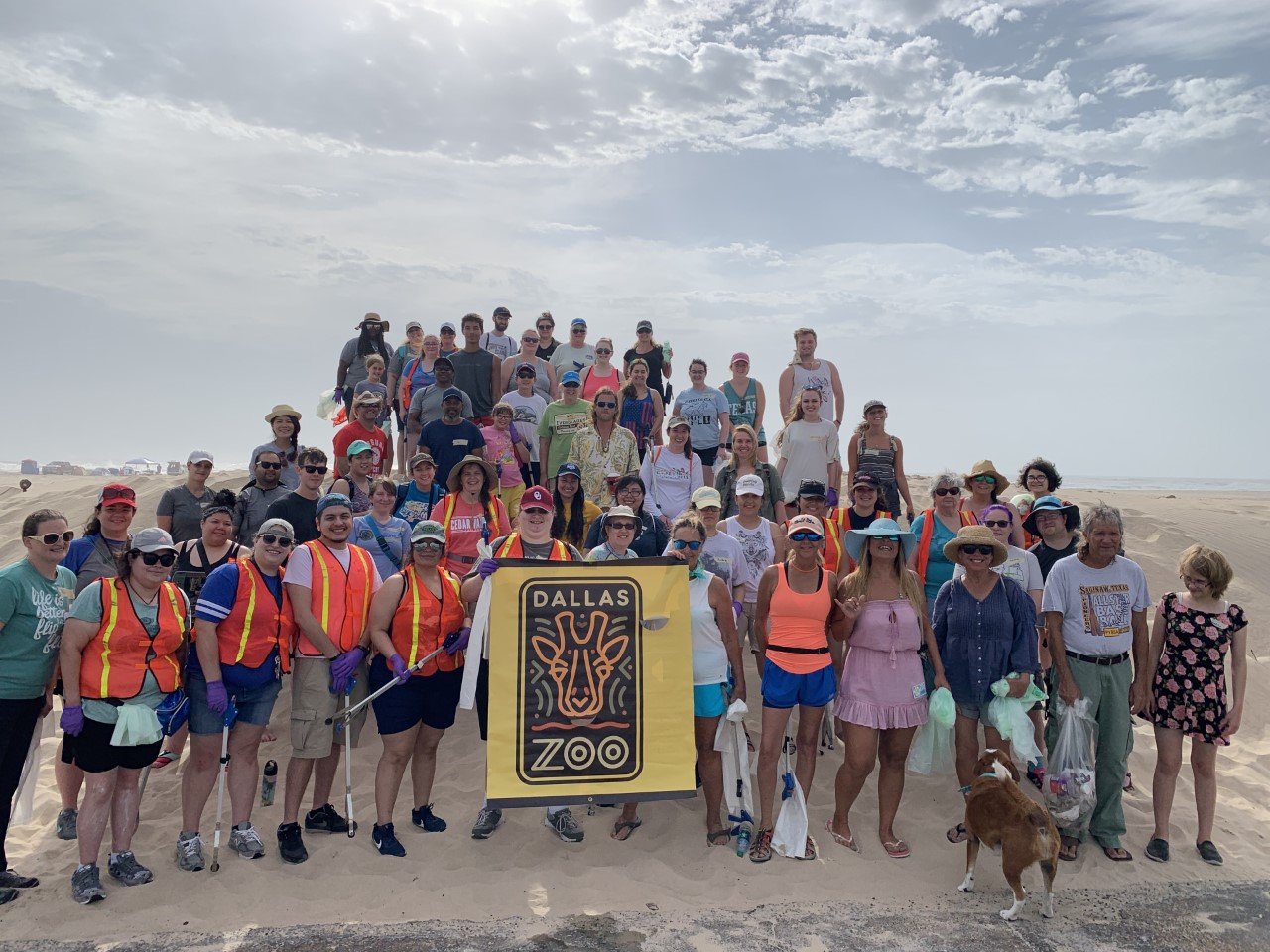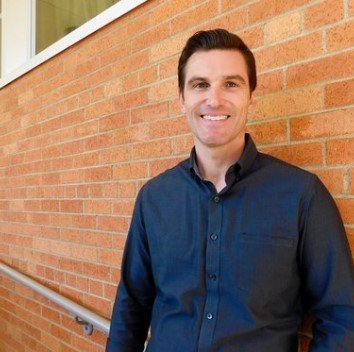Story by Jan Osborn. Photos courtesy of Dallas Zoo.
With 106 acres to explore, thousands of animals to visit, and a wide variety of family activities, there is plenty to experience at the Dallas Zoo! But behind the scenes, the staff and committed volunteers work tirelessly to save animals from extinction worldwide – starting with the smallest of species in our backyard. Katie Emmons has worked at the Dallas Zoo since 2018 in various roles but is currently the Conservation Programs Coordinator. Here, she works to further the Zoo’s “Protecting the 12” conservation initiative. She is specifically focused on the Dallas Zoo’s Texas Wildlife priority and seeks to better engage with the community and their conservation partners within that priority.
We recently had the opportunity to visit with Katie Emmons about the Dallas Zoo’s Wild Earth Action Team.
Katie Emmons and Michelle Davis weigh trash at the June 22 pickup.
We hear being Conservation Programs Coordinator is your favorite position with the Dallas Zoo so far. Can you explain your role’s passion project of the Zoo’s Take Action initiative and the Wild Earth Action Team?
The Dallas Zoo’s Wild Earth Action Team is essentially all Dallas Zoo staff and volunteers. Whether they’re working on our development team to raise money for conservation, taking care of our animals, or engaging with our guests during their visit, we’re all a part of the Wild Earth Action Team. We are working toward the Zoo’s mission of Engaging People and Saving Wildlife. As a part of the Wild Earth Action Team, we work to engage our community in taking direct action for wildlife alongside our team through our Take Action Projects.
It’s wonderful to hear that staff and volunteers are coming together to protect wildlife! Can you share the varying levels of involvement and activities for our readers who want to get involved?
With our Take Action Projects, we really wanted to make sure that people from all walks of life had the opportunity to get involved in taking direct action for wildlife. For folks looking for a free, family-friendly way to act right here in Dallas, we offer to Take Action in Dallas opportunities like our monthly Saving Mussels: Litter Pick-Up events. For those looking for an action-focused, fun weekend getaway, we have our Take Action in Texas opportunities, like our Saving Sea Turtles and Saving Bats trips, where we travel to different parts of Texas to help support and learn from some of our Texas wildlife conservation partners. Eventually, we also hope to expand our Take Action Projects outside of Texas with Take Action in America opportunities to help support wildlife conservation throughout the country.
Those who don’t want to get their hands dirty but still want a fun and educational way to explore nature should check out our new ecotourism trips called Wild Earth Expeditions!
The public can attend two trips in the upcoming months: Rescuing Sea Turtles and Restoring Bat Habitats.
Padre sea turtle release.
Both the Rescuing Sea Turtles and Restoring Bat Habitats trips sound exciting and perfect for families of all ages. Can you share the objectives of these trips and what you hope attendees walk away knowing?
So, right now, we have two Take Action Projects in Texas that will focus on supporting our conservation partners with projects vital to their work conserving those species. Saving Sea Turtles took place July 17-18, 2022, in South Padre Island, TX. Together we learned about sea turtle conservation and ecology while helping our partners at Sea Turtle, Inc. with essential conservation projects like habitat restoration, beach clean-up, and barrier protection maintenance. We also helped with gift shop inventory and deep cleaning their response vehicles because everything you do is important when you’re working to save a species.
Saving Bat Habitats attendees will travel to San Antonio, TX, this September 16-17, 2022. Together we will learn about bat conservation and ecology while helping our partners at Bat Conservation International with important conservation projects like Invasive species removal and erosion control. In the evening, we will witness the extraordinary emergence at Bracken Cave, where 15 million Mexican free-tailed bats raise pups and set out each summer evening to feed.
These trips not only strengthen our partnerships with these organizations and connect our guests with the organizations we support, but we’re also hoping that the participants who make the journey with us walk away with a better understanding of exactly what goes into saving species like the sea turtles and bats.
It’s incredible that the Dallas Zoo is able to offer restoration trips in our home state of Texas. But with so many animal species in need, how does the Zoo decide what to focus on?
Deciding which species to focus on is definitely not an easy decision; if we had the time and resources to save them all right now, you know we would! Previously, our efforts felt more “an inch deep and a mile wide,”—so while we were supporting quite a few projects, the impact long-term was hard to pin down. We decided that we needed to more consciously and proactively streamline our efforts and decide which species we wanted to support directly. In 2018 we launched our Protecting the 12 conservation initiative to do just that. Through Protecting the 12, we selected 12 species or groups of species to focus on over the next 12 years. Some of the species we selected are ones that your Dallas Zoo has a long history with, like okapi and elephants. Others, like Texas wildlife, were just obvious, natural fits.
We also ran into some issues with deciding our Take Action Project names. As we’re going to work with one of our Texas wildlife conservation partners who focus on a specific species, we easily decided to name the trip after that specific Texas species. We did this mainly because we wanted to make sure that everyone who participates in a Take Action Project with us understands the actions they’re taking during the event directly impact a specific animal. But, naming the Take Action Projects in Dallas was a little more complicated. These local projects are focused around a very specific action, like picking up litter, so we wanted to choose a species that is impacted by the issue we’re trying to address.
Sea turtle release.
We recently heard about a Take Action Project in South Dallas called, Saving Mussels: Litter Pick-Up. What are you looking to teach at these events, and what do you think the event’s impact has on our community?
Sometimes, living in a city, it’s easy to feel separate from nature, and it can be really hard to make the connection between yourself and wildlife. For our Take Action Projects in Dallas, we try to host at least one Saving Mussels: Litter Pick-up each month. That way, there are plenty of opportunities throughout the year for the community to connect with the more natural spaces within the city and understand how our actions here in Dallas affect wildlife. Picking up litter helps the animals and people in our community and everyone living in or near the Trinity River!
All kinds of wildlife have been documented to be negatively impacted by litter pollution, from birds using pieces of trash to build their nests, causing their nests to be too hot for their eggs and young chicks, to turtles, found entangled in fishing line. And eventually, all trash will find its way into our waterways, like the Trinity River, ending up in our drinking water and traveling down our rivers and into the ocean. Even the freshwater mussels that live in the Trinity River, which are filter feeders and critical in keeping the water clean, can’t escape it. Plastic doesn’t ever really decompose; it just breaks down into smaller and smaller pieces. We’re finding that those pieces are getting so small that the mussels can filter them out of the water. And as I’m sure you can imagine, just like it’s not healthy for humans to eat plastic, it’s not good for mussels, or other wildlife, either.
Katie Emmons, Thelva Balkus and Michelle Davis at the June 22 pickup.
One person can make a difference by picking up the trash they see in their own neighborhood, and that’s the conservation message we try to teach at these events. We want to get people not just to see nature but actually start doing something tangible, so they will feel more attached to the end result and care more about the outcome.
Thank you for all the work you and your team do to protect our natural habitat. For those called to action and who want to help, are there any age restrictions to participate in these Take Action Projects? Who would be an ideal candidate to preserve Dallas wildlife?
Anyone can join us at one of our Take Action Projects! We normally recommend them for ages 6+ just because of the physical nature of the activities, but we leave it up to the parent’s discretion for most projects since they know their kids best. It’s also important to double-check the information on our website for each individual Take Action Project you’re interested in, as some of the trips have different age restrictions based on the requirements of our partners.
Padre Group pick up beach litter.
The Dallas Zoo is a nonprofit 501(c)(3) organization. For more information on upcoming Take Action projects or other travel opportunities, please visit https://www.dallaszoo.com/save-wildlife/take-action-projects/. To stay up to date on the Dallas Zoo’s preservation efforts, sign up for their monthly conservation newsletter here, and be sure to follow the Dallas Zoo on social media.
Featured
more good stories
Featured
Josh Taylor was deployed to the Middle East, flying missions into Iraq, Afghanistan, and Syria, when he realized that many of the people he spoke to were divided. It was 2018, and Josh had already been in the Armed Forces for over ten years, but he wanted to find a cause that could unite the nation. “Flying 65,000 miles and spending 300 hours in a machine gives somebody a moment to think,” Josh says. Eventually, he found his answer– our youth, and alongside them, our educators– have the strength to be the foundation for our country.
When Lisa Wong launched the STEM program at Trinity Christian Academy, her goal and passion was to teach the kids that they can use STEM fields to bless others in the world around them. She views her time as an investment in the future.








